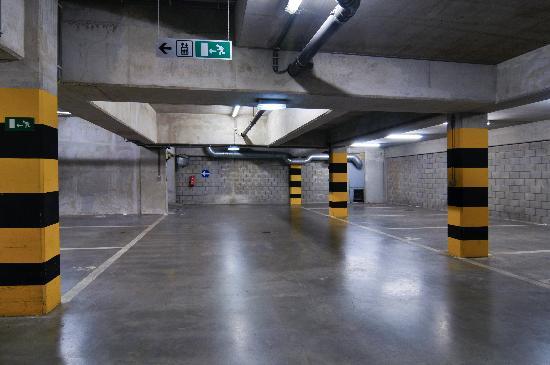Underground car park
A car park is a designated area or building where cars and other vehicles can be parked and left temporarily. In American English, it is referred to as a ‘parking lot’. Car parks are a common feature of the built environment, and often adjoin shopping centres, public buildings, schools, sports or entertainment venues, and so on.
For more information, see Car park.
Underground car parks are parking facilities that are built beneath the ground, either in the basement of a building or beneath a street. The primary advantage to this type of car park is that it can be developed in high-density urban areas where street-level space is at a premium. It is also hidden from view, and can provide enhanced security and weather protection for vehicles. However, access to and from underground car parks can be complex, as can building services such as lighting and ventilation, and they are typically expensive to excavate and construct. Security and safety measures must also be in place to prevent unauthorised access, provide surveillance and to facilitate escape in the event of an emergency.
Underground car parks can be constructed using steel sheet piles as a retaining structure, and concrete floors can be designed to stabilise the finished structure.
[edit] Related articles on Designing Buildings
- Basement excavation.
- Car park.
- Integrated transport system.
- Multi-storey car park.
- Planning (Subterranean Development) Bill.
- Overview of the road development process.
- Road traffic management.
- Tired of the commute? It might be time to take cars underground.
- Traffic engineering.
- Transport design and health.
- Types of road and street.
- Underground.
- Underground space.
Featured articles and news
Amendment to the GB Energy Bill welcomed by ECA
Move prevents nationally-owned energy company from investing in solar panels produced by modern slavery.
Gregor Harvie argues that AI is state-sanctioned theft of IP.
Heat pumps, vehicle chargers and heating appliances must be sold with smart functionality.
Experimental AI housing target help for councils
Experimental AI could help councils meet housing targets by digitising records.
New-style degrees set for reformed ARB accreditation
Following the ARB Tomorrow's Architects competency outcomes for Architects.
BSRIA Occupant Wellbeing survey BOW
Occupant satisfaction and wellbeing tool inc. physical environment, indoor facilities, functionality and accessibility.
Preserving, waterproofing and decorating buildings.
Many resources for visitors aswell as new features for members.
Using technology to empower communities
The Community data platform; capturing the DNA of a place and fostering participation, for better design.
Heat pump and wind turbine sound calculations for PDRs
MCS publish updated sound calculation standards for permitted development installations.
Homes England creates largest housing-led site in the North
Successful, 34 hectare land acquisition with the residential allocation now completed.
Scottish apprenticeship training proposals
General support although better accountability and transparency is sought.
The history of building regulations
A story of belated action in response to crisis.
Moisture, fire safety and emerging trends in living walls
How wet is your wall?
Current policy explained and newly published consultation by the UK and Welsh Governments.
British architecture 1919–39. Book review.
Conservation of listed prefabs in Moseley.
Energy industry calls for urgent reform.


























Comments
where is says "authorised access" i believe it should be "Unauthorised"
Fixed thanks